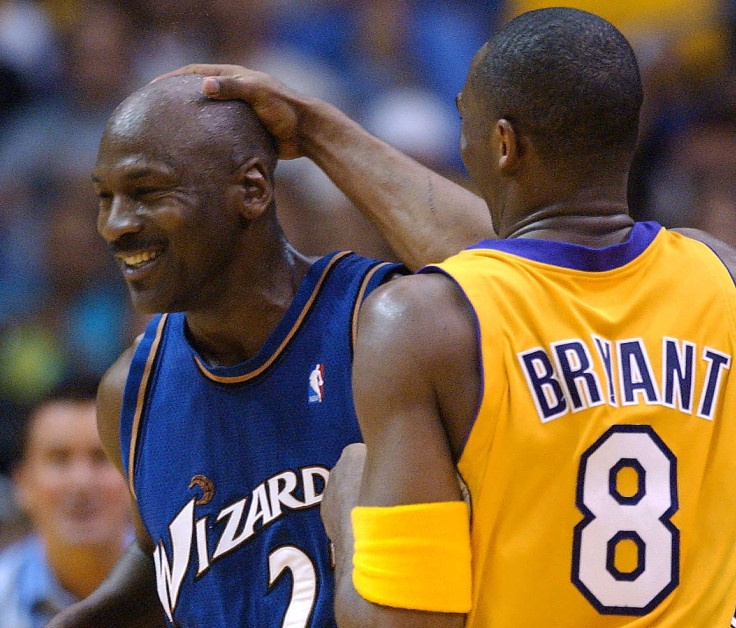Kobe Bryant, Michael Jordan Comparison: Despite NBA Scoring List, Bulls Legend Dominates Off The Court

For the past two decades, Los Angeles Lakers star Kobe Bryant has attempted to validate the on-court comparisons between himself and the consensus greatest player in NBA history, Michael Jordan. Bryant finally gained a measure of victory over his longtime rival on Sunday, when a second-quarter free throw against the Minnesota Timberwolves allowed him to pass Jordan for third place on the NBA’s all-time scoring list.
But regardless of where you stand on the Bryant vs. Jordan debate, the Chicago Bulls legend remains the gold standard in terms of athlete brands away from the court. At 36 years old and with his legacy more or less determined, no on-court accomplishment or international marketing effort would allow Bryant to exceed Jordan’s earning potential, experts said.
“I don’t think there’s anything he can do that would have him surpass Michael from a branding perspective,” said Brendan Dwyer, director of research and distance learning at Virginia Commonwealth University’s Center for Sport Leadership. “He’s always going to be seen as the replication of the original.”
Bryant began his career in 1996, just as Jordan was entering the downswing of his dominant career with the Bulls. From the beginning, Bryant’s competitive drive, work ethic and style of play drew comparisons to Jordan.
Bryant embraced the link. Phil Jackson, who mentored both players during his time as coach of the Bulls and then the Lakers, said in his 2013 book “Eleven Rings” that Bryant was “hell-bent on surpassing Jordan as the greatest player in the game.”
But even with Bryant’s rise on the all-time scoring list, Jordan is still considered the more-accomplished player. He required 197 fewer games and 783 fewer shots to reach his 32,292 career points. He also remains ahead of Bryant in terms of career playoff points, points per game, career MVP awards, NBA titles and single-season scoring titles, according to ESPN.
From a marketing and earnings perspective, the disparity between the two is even greater. Despite Bryant’s $30 million annual salary – the highest of any NBA player – Jordan dominates in terms of annual earnings.
The revenue Jordan’s portfolio generates is staggering. Nike paid him more than $100 million in royalties from its Jordan Brand in 2013 alone, ESPN’s Darren Rovell reported in August. The brand’s total sales reached $2.7 billion that same year.
Along with his Nike brand – long considered the marketing world’s benchmark for athlete superstardom – Jordan holds deals with Hanes, Gatorade and Upper Deck. Bolstered by his crossover appeal, Jordan earned more than any athlete except boxer Floyd Mayweather last year, active or retired. Decades of tens of millions of dollars in annual earnings allowed Jordan to gain a majority stake in the NBA’s Charlotte franchise and, ultimately, to become a billionaire in 2014, Forbes reports.
Jordan is so synonymous with athlete branding that every NBA player who came after him has molded his marketing effort in his image. Bryant’s biggest endorsement deal is with Nike, but Jordan has his own wing of the company. Fellow NBA star LeBron James grew up watching Jordan play and wears the number 23 in his honor. Bryant’s failure to adequately distinguish his brand from Jordan is a major reason why he earns so much less than his rival.
“That’s where Kobe failed. He didn’t make [his brand] unique and distinctive. He made it too similar to what Jordan has done. He was very successful on the court, I don’t think he’ll ever be as successful off of it,” Dwyer said.
Jordan’s continuing financial success can also be attributed to the era in which he played. Jordan stood alone throughout his career as the NBA’s most marketable player, displaying the charisma and charm that contemporaries such as Boston Celtics great Larry Bird or Detroit Pistons legend Isaiah Thomas lacked. Bryant plays in an era where hyper-marketable mega stars like James and Oklahoma City Thunder Kevin Durant compete for shares of the sports apparel business.
The media’s landscape was also different in the 1990’s. Jordan mostly evaded the scrutiny that his gambling habit or other off-court antics would draw if he played in the present day. Bryant grew up and played after the advent of the 24-7 news cycle, where every practice outburst is worthy of coverage. Allegations in 2003 that Bryant sexually assaulted a woman in a Colorado hotel room never amounted to criminal charges, but virtually destroyed his marketability for a time.
Bryant may not bring in as much money as Jordan off the court, but he remains successful in his own right. His $61.5 million in 2014 earnings ranks fifth among the world’s athletes, Forbes notes. And Bryant has actually surpassed Jordan in one aspect of his business strategy – the pursuit of overseas markets.
As a top-five NBA star in an era of unprecedented global growth for the league, Bryant has established himself as a major player in China, one of the world’s largest economies. He has made repeated trips to China to meet with local fans and play one-on-one against Chinese students. He’s starred in Chinese television commercials and established local charities. This dedication to cultural outreach manifested itself in a tangible way – Bryant’s jersey outsells that of Yao Ming, China’s most notable export to the NBA, the Wall Street Journal reported in 2009.
“[Bryant], more than a lot of the other athletes I’ve seen, has an appreciation for how important it was to build cultural relevancy and credibility and he’s done it in a very authentic and deliberate way,” said Paul Swangard, managing director of the University of Oregon’s Warsaw Sports Marketing Center.
But even in China, there’s evidence that Bryant’s success is just an extension of Jordan’s global ubiquity. “He reminds everyone of Michael Jordan,” Chinese sportswriter Shen Zhiyu told the Wall Street Journal.
© Copyright IBTimes 2025. All rights reserved.






















